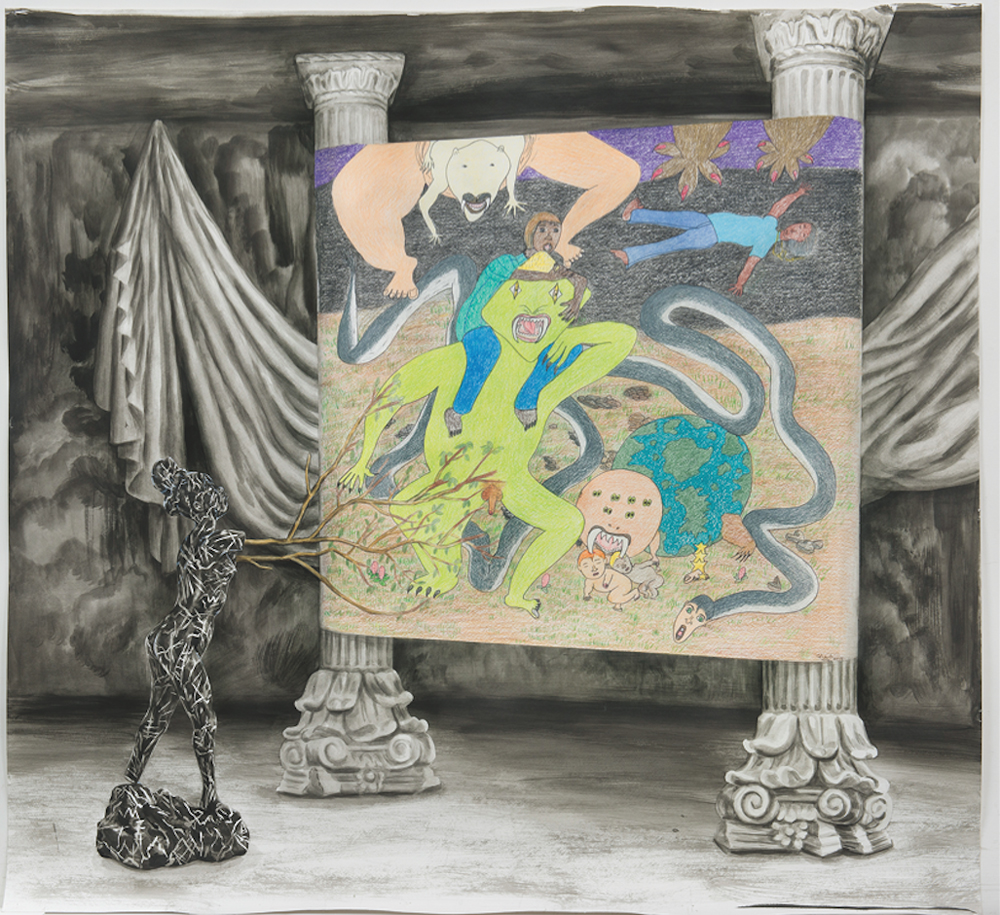Ideas of hybridity, transgression and the marginal are often aligned with politics of subversion, resistance and dissent. This is particularly true for art that ventures into the realms of the fantastic or grotesque, infecting the everyday with an otherness that, in the words of Mikhail Bakhtin (as translated by Hélène Iswolsky), “discloses the potentiality of an entirely different world, of another order, another way of life.” Celebrated for revealing a hidden political reality, or warping the status quo beyond recognition, such art is said to use monsters, mutation and estrangement in service of a heretical worldview.
Both Shary Boyle and Shuvinai Ashoona have had their work framed in this way, and their recent joint exhibition offered ample fodder for such an interpretation. Organized by Pierre-François Ouellette art contemporain in partnership with Feheley Fine Arts, “Universal Cobra” was a spellbinding exhibition that explored chimeras of imagination and otherness.
Its lodestone was a suite of six drawings created according to a loose version of the exquisite-corpse methodology, with each artist preparing incomplete drawings, leaving white space for their counterpart to fill. The resulting compositions—created during a week spent hanging out, listening to music and cracking jokes at the Kinngait Studios, Cape Dorset, Nunavut—are alive with hybrid creatures, surreal morphology, amusing non-sequiturs and provocative juxtapositions of European and Inuit cultural references.
The exhibition is rounded out with a careful selection of drawings, done by each artist separately, as well as their first collaborative work, Universal Cobra Pussy (2011), and several of Boyle’s porcelain sculptures. Bold yet vulnerable, the latter are displayed without vitrines on a specially built plinth that winds through the centre of the gallery like a snake, or an ice floe.
It is certainly tempting to read this exhibition’s intricate blend of monstrosity, humour, beauty and myth as a kind of ideological critique, but that’s not the only interpretation. “Universal Cobra” provocatively mixes imagination and politics with skilful references to mythology, art history, sexuality, colonialism and capitalism.
But it is also fundamentally about cooperation and friendship. The multi-headed monsters, Greco-Roman statuary, strange beasts and hybrid creatures that fill it thus hold a dual significance: they disturb, their blurred boundaries undermining cultural norms and wreaking havoc with our sense of reality; and they bestow hope, demonstrating how seemingly incompatible and disparate particulars can come together to form new, cooperative unities.
This is a review from the Spring 2016 issue of Canadian Art. To read selected stories from this issue, visit its table of contents. To get every issue delivered to your door before it hits newsstands, visit canadianart.ca/subscribe.

 Shuvinai Ashoona and Shary Boyle, Black Marble, 2015. Ink on paper and coloured pencil, 91 x 107 cm. Courtesy Feheley Fine Arts/Pierre-François Ouellette art contemporain.
Shuvinai Ashoona and Shary Boyle, Black Marble, 2015. Ink on paper and coloured pencil, 91 x 107 cm. Courtesy Feheley Fine Arts/Pierre-François Ouellette art contemporain.







